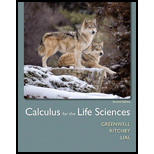
Calculus For The Life Sciences
2nd Edition
ISBN: 9780321964038
Author: GREENWELL, Raymond N., RITCHEY, Nathan P., Lial, Margaret L.
Publisher: Pearson Addison Wesley,
expand_more
expand_more
format_list_bulleted
Question
Chapter 14.CR, Problem 8CR
To determine
Whether the statement “If the equation
Expert Solution & Answer
Want to see the full answer?
Check out a sample textbook solution
Students have asked these similar questions
The U.S. government's focus on supply reduction efforts in its "war on drugs" has been relatively unsuccessful at addressing illegal drug use. Some economists believe that a successful anti-drug program must concentrate on reducing demand; for example, through drug education and voluntary treatment programs for addicts.
Suppose the price elasticity of demand for cocaine is -0.5. What will happen to the equilibrium price, quantity, and total revenue from cocaine sales if the government succeeds in its efforts to reduce demand? What is likely to happen to the incentive to sell cocaine?
Suppose the government continues to concentrate its efforts on supply reduction and is able to reduce the supply of cocaine. As a result of the reduction in supply the price of cocaine increases by 25 percent. If the price elasticity of demand is -0.5, what is likely to happen to the incentive to sell cocaine?
Based on your answers, explain why one approach might be preferred over the other.
The Krill which are tiny shrimplike creatures are the principal food source for the huge blue whale. The intrinsic growth rate and the carrying capacity of the blue whale are estimated at 5% per year and 150,000 respectively. The maximum sustainable population for krill is 600 tons/acre. In the absence of predators, in uncrowded conditions, the krill population grows at a rate of 20% per year. The pres-ence of 600 tons/acre of krill increases blue whale population growth rate by 2.5% per year, and the presence of 150,000 blue whales decreases krill growth rate by 8% per year.
(a) Determine all the steady states of the system and analyze theri stability. Can the blue whales and the krill coexist?
(b) Verify your conclusion of stability by plotting the solution and the vector fields for selected values of initial populations.
(c) Describe what happens to the two populations over time. Assume that we start o with 10,000 blue whales and 500 tons/acre of krill.
(d) How sensitive are…
Chapter 14 Solutions
Calculus For The Life Sciences
Ch. 14.1 - YOUR TURN 1 Find the first four terms of the...Ch. 14.1 - Prob. 2YTCh. 14.1 - Prob. 3YTCh. 14.1 - Prob. 4YTCh. 14.1 - Prob. 1ECh. 14.1 - Prob. 2ECh. 14.1 - Prob. 3ECh. 14.1 - Prob. 4ECh. 14.1 - Prob. 5ECh. 14.1 - Prob. 6E
Ch. 14.1 - Prob. 7ECh. 14.1 - Prob. 8ECh. 14.1 - Prob. 9ECh. 14.1 - Prob. 10ECh. 14.1 - Prob. 11ECh. 14.1 - Prob. 12ECh. 14.1 - Prob. 13ECh. 14.1 - Prob. 14ECh. 14.1 - Prob. 15ECh. 14.1 - Prob. 16ECh. 14.1 - Prob. 17ECh. 14.1 - Prob. 18ECh. 14.1 - Prob. 19ECh. 14.1 - Prob. 20ECh. 14.1 - Prob. 21ECh. 14.1 - Prob. 22ECh. 14.1 - Prob. 23ECh. 14.1 - Prob. 24ECh. 14.1 - Ricker Model Another model of population growth...Ch. 14.1 - Prob. 26ECh. 14.1 - Prob. 27ECh. 14.1 - Beverton-Holt Model Another model of population...Ch. 14.1 - Prob. 29ECh. 14.1 - Prob. 30ECh. 14.1 - Shepherd Model The Shepherd model, a modification...Ch. 14.1 - Prob. 32ECh. 14.1 - Prob. 33ECh. 14.2 - Find equilibrium points x, 0x1, for each of the...Ch. 14.2 - Prob. 2ECh. 14.2 - Prob. 3ECh. 14.2 - Prob. 4ECh. 14.2 - Prob. 5ECh. 14.2 - Prob. 6ECh. 14.2 - Prob. 7ECh. 14.2 - Prob. 8ECh. 14.2 - Prob. 9ECh. 14.2 - Prob. 10ECh. 14.2 - Prob. 11ECh. 14.2 - Prob. 12ECh. 14.2 - Prob. 13ECh. 14.2 - Prob. 14ECh. 14.2 - For each of the following functions, already...Ch. 14.2 - Prob. 17ECh. 14.2 - Prob. 18ECh. 14.2 - Prob. 19ECh. 14.2 - Prob. 20ECh. 14.2 - Prob. 21ECh. 14.3 - Prob. 1YTCh. 14.3 - Prob. 1ECh. 14.3 - Prob. 2ECh. 14.3 - Prob. 3ECh. 14.3 - Prob. 4ECh. 14.3 - Prob. 5ECh. 14.3 - Prob. 6ECh. 14.3 - Prob. 11ECh. 14.3 - Prob. 12ECh. 14.3 - Repeat the instruction of Exercise 11 for the...Ch. 14.3 - Prob. 14ECh. 14.3 - Prob. 15ECh. 14.3 - Prob. 16ECh. 14.3 - Prob. 17ECh. 14.3 - Prob. 18ECh. 14.3 - Prob. 19ECh. 14.CR - CONCEPT CHECK For Exercise 1-8 determine whether...Ch. 14.CR - Prob. 2CRCh. 14.CR - Prob. 3CRCh. 14.CR - Prob. 4CRCh. 14.CR - Prob. 5CRCh. 14.CR - Prob. 6CRCh. 14.CR - Prob. 7CRCh. 14.CR - Prob. 8CRCh. 14.CR - Prob. 9CRCh. 14.CR - Prob. 10CRCh. 14.CR - Prob. 11CRCh. 14.CR - Prob. 12CRCh. 14.CR - Find the next 4 terms of the sequence satisfying...Ch. 14.CR - Prob. 14CRCh. 14.CR - Prob. 15CRCh. 14.CR - Prob. 16CRCh. 14.CR - Prob. 17CRCh. 14.CR - Prob. 18CRCh. 14.CR - Prob. 19CRCh. 14.CR - Prob. 20CRCh. 14.CR - Prob. 21CRCh. 14.CR - Prob. 22CRCh. 14.CR - Prob. 23CRCh. 14.CR - Prob. 24CRCh. 14.CR - For each of the following functions, do the...Ch. 14.CR - Prob. 26CR
Knowledge Booster
Learn more about
Need a deep-dive on the concept behind this application? Look no further. Learn more about this topic, calculus and related others by exploring similar questions and additional content below.Recommended textbooks for you
- Algebra & Trigonometry with Analytic GeometryAlgebraISBN:9781133382119Author:SwokowskiPublisher:Cengage

Algebra & Trigonometry with Analytic Geometry
Algebra
ISBN:9781133382119
Author:Swokowski
Publisher:Cengage
Trigonometry - Harmonic Motion - Equation Setup; Author: David Hays;https://www.youtube.com/watch?v=BPrZnn3DJ6Q;License: Standard YouTube License, CC-BY
Simple Harmonic Motion - An introduction : ExamSolutions Maths Revision; Author: ExamSolutions;https://www.youtube.com/watch?v=tH2vldyP5OE;License: Standard YouTube License, CC-BY